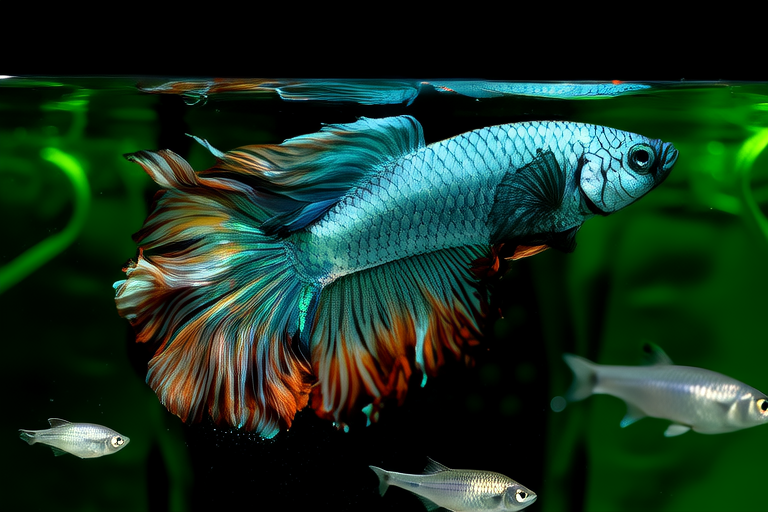Betta Fish vs Other Aquarium Fish: Compatibility Tips
Introduction: Understanding Betta Fish Behavior
Betta fish, also known as Siamese fighting fish, have earned their reputation for being aggressive towards other males of their kind. Males are particularly territorial and will often engage in violent confrontations when housed with another male or even reflections of themselves. This aggressive nature stems from their evolutionary history, where they competed for limited resources and mates in the wild. However, female bettas can be somewhat more tolerant of each other but still require ample space to avoid conflicts.
Beyond their aggression, bettas are generally solitary creatures that prefer swimming alone or in pairs. They are active swimmers and enjoy exploring their environment. Bettas are also known for their vibrant colors and long, flowing fins, making them popular choices for home aquariums. Their unique behavior and appearance make them an interesting addition to any tank, but it is crucial to carefully consider the compatibility of other fish species before introducing them into the same habitat.
Compatible Species: Factors to Consider
Temperament
When selecting tankmates for betta fish, it is essential to choose species with similar temperaments. Peaceful, non-aggressive fish are ideal companions for bettas. Examples include small tetras such as neon tetras, cardinal tetras, and ember tetras. These tetras are schooling fish that tend to stay in groups, which helps to minimize direct interactions with the betta. Additionally, species like danios, which are known for their high energy levels and darting movements, can be good companions as they usually keep moving and thus reduce the chances of provoking the betta.
Size
Size differences between the betta and potential tankmates are critical. It is advisable to avoid larger fish that could potentially bully or prey on the betta. Similarly, very small fish might be perceived as food by the betta due to their size. Optimal tankmates should be of a similar size or slightly smaller than the betta. Some suitable options include dwarf gouramis, which are comparable in size and share a similar peaceful demeanor. Other compatible species include cherry barbs and harlequin rasboras.
Water Conditions
Betta fish thrive in specific water conditions, including a temperature range of 76 to 82 degrees Fahrenheit (24 to 28 degrees Celsius) and a pH level between 6.5 and 7.5. Therefore, it is important to select fish that can tolerate these conditions. For example, guppies and mollies are excellent choices as they can adapt well to the same water parameters preferred by bettas. On the other hand, fish that require cooler temperatures or significantly different pH levels should be avoided.
Incompatible Species: Reasons for Incompatibility
Aggressive Fish
Fish that exhibit aggressive behavior, such as cichlids, can be highly incompatible with bettas. Cichlids are known for their territorial nature and may initiate fights with the betta, leading to injury or death. Similarly, other aggressive species like angelfish and certain types of loaches should be avoided. These fish may perceive the betta as competition for resources or territory and respond aggressively.
Fin-Nippers
Some fish are notorious for nipping at the fins of others, which can be particularly harmful to bettas due to their long, delicate fins. Species like tiger barbs, serpae tetras, and certain types of danios are known fin-nippers. These fish can cause significant stress and physical harm to the betta, making them unsuitable tankmates.
Different Water Conditions
Fish that require vastly different water conditions than those preferred by bettas should not be housed together. For instance, discus fish need warmer and more acidic water, which would be detrimental to the health of the betta. Similarly, goldfish thrive in cooler water with lower pH levels, making them incompatible with bettas. Ensuring that all tank inhabitants can thrive in the same water conditions is crucial for maintaining a healthy aquarium.
Setup Tips for a Harmonious Environment
To create a harmonious environment for your betta and its tankmates, consider the following setup tips:
Planting Aquatic Plants
Adding aquatic plants to the tank can provide hiding spots and create a more natural environment for both the betta and its companions. Plants like java fern, anubias, and amazon swords are excellent choices as they are hardy and can thrive in the same conditions as bettas. These plants not only enhance the aesthetic appeal of the tank but also offer refuge for smaller fish, reducing direct contact with the betta.
Setting Up Obstacles
Placing obstacles such as rocks, driftwood, and caves within the tank can help break up the line of sight between the betta and other fish. This reduces the likelihood of confrontations and allows each fish to establish its own territory. Ensure that the obstacles are placed in a way that does not restrict swimming space or overcrowd the tank.
Adequate Space
Providing ample space is crucial for preventing overcrowding and reducing stress among tank inhabitants. A general rule of thumb is to allow at least 2-3 gallons of water per inch of fish. This ensures that all fish have enough room to swim freely without feeling cramped or threatened.
Summary: Key Factors for Maintaining a Harmonious Community
Maintaining a harmonious community in your aquarium requires careful consideration of several key factors. First and foremost, understanding the behavior and preferences of each species is essential. By choosing tankmates with similar temperaments, appropriate sizes, and compatible water conditions, you can create a peaceful environment for all inhabitants. Additionally, setting up the tank with adequate space, aquatic plants, and obstacles can further promote harmony. Regular monitoring of the tank’s water quality and the health of the fish is also crucial for ensuring a thriving ecosystem. With proper planning and care, you can enjoy a beautiful and balanced aquarium that provides a rewarding experience for both you and your fish.
